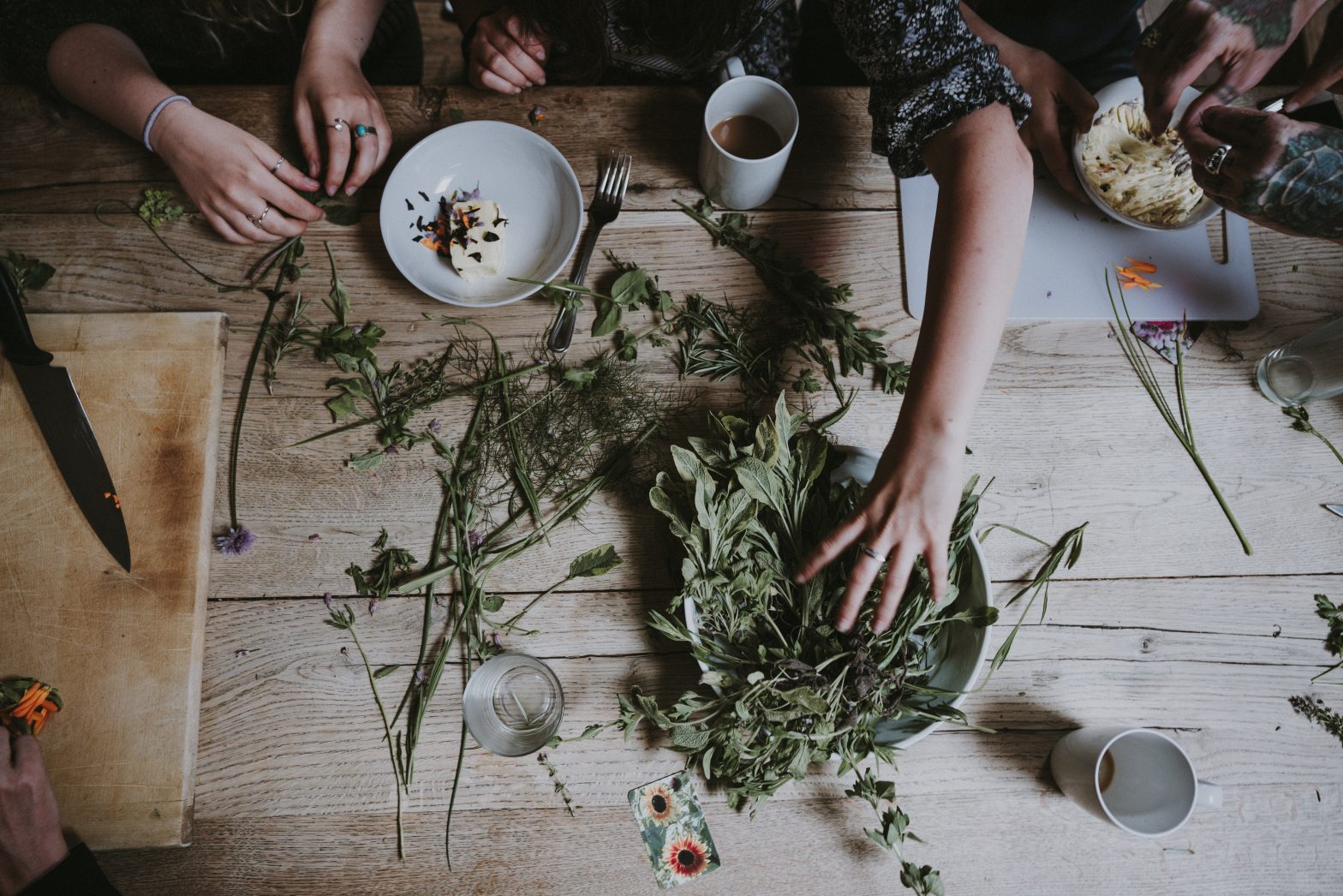Stuffy noses, scratchy throats, upset stomachs – we have all been there. Just as we have all felt under the weather, most people also have their favorite at-home remedies. Most revolve around herbs, like my Italian father’s lemon thyme tea ; he swears it cures an upset stomach better than any over-the-counter solution. Herbs have been used for their medicinal properties for over 5,000 years across the world1. While some illnesses require a trip to the doctor and prescribed medication, harnessing the healing power of plants can do the trick in a pinch and without having to leave the comfort of your couch.
Upset Stomach
Ginger
A stomachache is no match for what ginger can do. The fragrant root contains important enzymes and compounds known as gingerols2. When consumed, these compounds go to work, curbing nausea, and effectively dispelling gas from the body3. Together, these two functions aid in digestion, getting you feeling better faster. To reap these benefits, chew on a 1 inch piece of ginger, or slice up and steep in hot water to create a tea.3
Luckily, ginger is simple to grow at home! Begin by creating two inch cuttings. Leave the cuttings out overnight to form a callous. Once dried, place your cuttings under soil, water well, and give lots of sun4. Within two weeks you should see sprouts!
Once the plant is established, give your ginger plant a home on a windowsill to ensure lots of sunlight. Ginger plants are also great to supplement with compost as it thrives on soil rich in organic matter. Finally, make sure your ginger plant does not dry out. Moist well draining soil is essential for early growth.
Bay Leaf
Bay leaves have historic roots in Greece and Rome, being heralded as a royal plant. Bay leaves were even used to create laurel crowns5. Dried bay leaf today is commonly used as a seasoning in a variety of sauces and stews. Along with contributing to tasty dishes, bay leaf has properties known for alleviating a rumbly stomach. These properties stem from enzymes that are associated with relief of abdominal cramping and gas.6 Like ginger, bay leaves can be steeped in hot water to create an effective tea7. Not only will your stomach feel good but your kitchen will smell good too!
The bay leaf is grown from the bay tree. Native to Asia, the bay tree needs ample room to grow. The bay tree also requires full sun exposure, lots of water, and soil chock full of organic matter.8 With winter upon us, it is also important to note that the bay tree is a hardy plant having the ability to tolerate frost8. The bay tree is not known for its strong wood, so protection from windy areas is necessary.8
Congestion
Peppermint
While peppermint may be a popular addition to holiday-time treats, this herb is extremely helpful for those suffering from congestion. Peppermint contains menthol which is known for dramatically improving airflow through the nose9. In addition, peppermint has anit-bacterial and anti-inflammatory properties making it perfect for treating overworked sinuses9. Peppermint can be steeped in boiling water to create a fragrant steam. By placing your face over the steam and taking deep breaths, the peppermint is able to work its magic9.
Peppermint is best grown indoors and within a container. This is due to its invasive properties when let free outside.10 Your peppermint will thrive in an area that receives full sun.10 Make sure your peppermint plant is thoroughly watered, never letting the soil go dry.10
Eucalyptus
Eucalyptus does much more than make a pretty decoration. The oils found within the eucalyptus tree are known for being powerful fighters against congestion. Like peppermint, traces of menthol and other compounds are found in the oil produced by eucalyptus leaves.11 These compounds are essential in clearing up blocked sinuses and breathing easier. To reap the full benefits of eucalyptus, gather full branches into a bunch, tie together at the ends, and hang in your shower. The steam from the water will encourage the leaves to release their oils.
Like the bay tree, eucalyptus is not an indoor friendly plant. The eucalyptus tree can grow up to 20 feet tall and just as wide.12 Because of this, you will want to ensure ample space for your tree to mature into, preferably in a sunny location. Once a space is selected, the eucalyptus tree favors well drained slightly acidic soil.13
Burns
Aloe
From relaxing on the beach to doing yard work, the strength of the suns’ rays are the same. Whether we forget to reapply our sun protection, or forget it all together, everyone knows how unpleasant a sunburn can be.
A trip down any grocery aisle will reveal that aloe is one of the most popular at-home remedies for such an injury, and for good reason. Aloe is full of active compounds that reduce inflammation and pain while encouraging repair.14 Clinical studies have shown that aloe is also effective at expediting the healing process in those who have sustained burns.14 To reap the benefits of the aloe plant, take one leaf and remove the skin on the top and bottom. Then, after removing the spines on either side of the leaf, apply the cool gel interior to the affected area.
The aloe plant is a type of succulent.15 This means it requires extremely infrequent but thorough waterings.15 If the top ⅓ of soil is dry, this means it is time to water! Aloe is best grown in an area that receives bright but indirect light.15 The soil should be well-draining, ideally a mix of bark, perlite, rock, and potting soil.15 Planting in a pot with drainage holes is essential.15
Honey
Honey is one of the most versatile and oldest forms of medicine. Used since the inception of herbal medicine, honey boasts a variety of positive effects, especially for those who have sustained a burn injury.16
Honey has it all. The thick liquid created by bees from flower nectar is known for being antibacterial, antifungal, all while battling inflammation.16 When used on burns, honey also draws in moisture, keeping the affected area moist, preventing the formation of a scab.16 Honey is also known for encouraging more rapid skin repair.
When self-treating burn injuries with honey there are a few important factors to keep in mind. Honey is effective at treating first-degree to mild second degree burns.17 Any burn more moderate or severe requires a call or visit to your doctor to ensure proper healing. To apply the honey, first coat a sterile gauze pad, and then apply to the affected area.17 Change the dressing up to three times a day to ensure cleanliness of the dressing.17 In preparation for possible injury, make sure you have medical grade honey.17 This product is held to a higher purity standard than your average store bought bottle. Finally, and most importantly, before applying anything to a burn or injury, ensure that that area is thoroughly cleaned.17 This will ensure that no further complications arise delaying the healing process or worsening your symptoms.
References
- Wikimedia Foundation. (2021, November 16). Herbal medicine. Wikipedia. Retrieved November 21, 2021, from https://en.wikipedia.org/wiki/Herbal_medicine#:~:text=Archaeological%20evidence%20indicates%20that%20the,who%20compiled%20lists%20of%20plants.
- Ginger – how long does it take to grow and harvest ginger? Texas A&M AgriLife Extension Service. (2019, February 8). Retrieved November 21, 2021, from https://agrilifeextension.tamu.edu/library/gardening/ginger/.
- MediLexicon International. (n.d.). Ginger: Health benefits and dietary tips. Medical News Today. Retrieved November 21, 2021, from https://www.medicalnewstoday.com/articles/265990#_noHeaderPrefixedContent.
- Ginger – how long does it take to grow and harvest ginger? Texas A&M AgriLife Extension Service. (2019, February 8). Retrieved November 21, 2021, from https://agrilifeextension.tamu.edu/library/gardening/ginger/.
- Larson, S. (2021, September 30). All about bay leaves. Escoffier. Retrieved November 21, 2021, from https://www.escoffier.edu/blog/culinary-arts/all-about-bay-leaves/.
- Perrone, V., says, D., Dianne, Says, R. P., & Persad, R. (2014, December 4). Stomach-soothing teas. Motive Nutrition. Retrieved November 21, 2021, from https://motivenutrition.com/stomach-soothing-teas/.
- Desk, N. D. T. V. F. (2018, November 30). Indigestion problem? here’s how bay leaf or Tej Patta could help manage your tummy troubles. NDTV.com. Retrieved November 21, 2021, from https://www.ndtv.com/food/indigestion-problem-heres-how-bay-leaf-or-tej-patta-could-help-manage-your-tummy-troubles-1955307.
- Sweet Bay Leaf Tree: How to grow a bay leaf tree. (n.d.). Retrieved November 21, 2021, from https://www.gardeningknowhow.com/edible/herbs/bay/sweet-bay-leaf-tree.htm.
- Groves, M. (2018, October 12). 12 science-backed benefits of peppermint tea and extracts. Healthline. Retrieved November 21, 2021, from https://www.healthline.com/nutrition/peppermint-tea#TOC_TITLE_HDR_5.
- Care of peppermint – how to grow peppermint plants. (n.d.). Retrieved November 21, 2021, from https://www.gardeningknowhow.com/edible/herbs/mint/growing-peppermint-plant.htm.
- Health topics A-Z. PeaceHealth. (n.d.). Retrieved November 21, 2021, from https://www.peacehealth.org/medical-topics/id/hn-2086009#hn-2086009-how-it-works.
- Eucalyptus makes a stunning container plant, houseplant, or landscape tree. Better Homes & Gardens. (n.d.). Retrieved November 21, 2021, from https://www.bhg.com/gardening/plant-dictionary/tree/eucalyptus/.
- Jeanroy, A. (2021, August 16). How to grow eucalyptus. The Spruce. Retrieved November 21, 2021, from https://www.thespruce.com/how-to-grow-and-use-eucalyptus-1762354.
- Aloe. Mount Sinai Health System. (n.d.). Retrieved November 21, 2021, from https://www.mountsinai.org/health-library/herb/aloe.
- verified), T. (not, The Editors 3 months 1 week ago In reply to Can pets eat aloe Vera by Tanya (not verified) Pets should not be allowed to eat or chew on aloe vera leaves, Editors, T., verified), V. M. R. (not, verified), J. (not, & verified), J. (not. (n.d.). Aloe Vera. Almanac.com. Retrieved November 21, 2021, from https://www.almanac.com/plant/aloe-vera.
- Zbuchea, A. (2014, March 31). Up-to-date use of honey for Burns Treatment. Annals of burns and fire disasters. Retrieved November 21, 2021, from https://www.ncbi.nlm.nih.gov/pmc/articles/PMC4158441/.
- Lindberg, S. (2020, March 17). 10 tips on Honey for burns. Healthline. Retrieved November 21, 2021, from https://www.healthline.com/health/honey-for-burns#medical-grade-honey.

